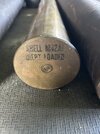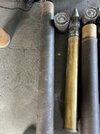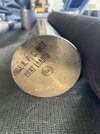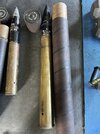pzgr40
Well-Known Member
Soon after the introduction of the M4 Sherman tank one found that the 75mm M3 gun of the M4 Sherman was inadequate when facing German tanks, which led to high losses of Sherman M4 tanks. The Sherman M4 was designed as an infantry support tank, not as a tank to hunt other tanks. To improve the anti-tank capacity of the Sherman tank the more powerful M1A1 tank gun was designed to replace the M4 gun.
In spite of the fact that the M1A1 gun was more powefull than the M4 gun, it was still insufficient when facing German armour. Only when the M36 Jackson with the 90mm M3 gun appeared the Allied troops coud face German tanks on equal terms.
Below the cutaway models of the 3” (76mm) M62A1 APC cartridge and the M42A1 HE cartridge as used in the M1A1/L55 high velocity gun as used in the improved Sherman M4A1. This Sherman tank had a better (longer barreled) gun than the original Sherman M4 with the L40 M3 Gun. The cartridges were also used in the M18 Hellcat tank hunter.
The M62A1 APC projectile exists of a steel, nose hardened body with an ogive shaped hole drilled in the base, threaded to receive the B.D. (Base Detonating) fuze M66A1. This fuze is delayed in its function, so the projectile can penetrate the target before exploding inside. The functioning of the fuze is simple: A brass cylinder with a firing pin on top is held away from the firing cap by an internally serraded brass resistance ring, forming “fingers” that fixates the cylinder in the lower position. At impact, the negative acceleration will throw the cylinder forward, bending the fingers upward, enabling the firing pin to hit the firing cap (green). Above the firing cap are two small chambers, the top one filled with a pellet of black powder that acts as a pyrotechnical delay. Above this pyrotechnic delay a detonator pellet is placed (copper) which ignites the booster charge and the main charge. The ogive shaped hole is filled with 65 grams of Explosive D (Ammonium picrate) On top of the hardened nose a piercing cap is attached by means of four 1 cm wide crimps. This softer steel piercing cap devides the force of the impact on the target over the entire nose, thus preventing the hardened nose from shattering upon impact. The top of the piercing cap is threaded to receive an aluminium windshield.
The shellcase is the brass shellcase M26. It is ignited by the M28B2 base igniter which has a pipe shaped black powder magazine which ignites the main charge fast en evenly.
Cartridge weight : 11,14 Kg (24,55 Lb)
Projectile weight : 7,00 Kg (15,43 Lb)
Lenght of complete round: 854mm
Length shellcase: 540 mm
Length projectile (with fuze): 355 mm
Vo.: 792 mtrs/sec.
Penetration: (@ 30 degrees from vertical) 93mm at 457 mtrs, 75 mm at 1828 mtrs.
The M42A1 HE cartridge consists of a pressed and machined steel body, fuzed with the
M48A2 nose fuze which is screwed in the M20A1 booster. The fuze M48A1 has no booster of its own, and the M20A1 booster is used to fill up the void.
The M20A1 booster has a brass body, and an aluminum cap screwed over the base of the body, containing the main charge. In the top of the booster a brass centrifugal safety disc is placed, locked up in safe position (the flash channel interrupted) by two safety pins, one a springloaded axial setback pin, locking the radial springloaded centrifugal safety pin that fixates the centrifugal safety disc. After firing the axial setback pin releases the radial safety pin, releasing the safety disc that now rotates the firing cap over the central exploder channel.
The fuze used is the M48A2 SQ (SuperQuick) & 0,15 seconds delay. The delay could be set by turning the screw on the outside of the fuzebody 90 degrees. In the top of the fuze is an impact detonator with a fixed firing pin above it. It is held away from the firing cap by a brass collar, 5 mm in dia and a 0,3mm wall thickness On impact ,the firing pin will be hammered down into the detonator (crushing the brass collar), passing its flame down through the tube into the booster. When the screw is set to open the channel, the cylinder swings out, caused by the centrifugal force, and opens the channel. This is the SuperQuick mode. It must be noted that the cylinder is placed in a appr. 15 degrees angle down to the center of the fuze. This is done to ensure that the setback force on firing is larger than the centrifugal force upon firing the gun. Therefore, the cilinder can only slide open when the acceleration is nearly over, appr. 25 mtrs in front of the barrel.
The lower inner portion of the fuze contains a steel bushing with a downward facing firing pin. Inside the bushing, a brass inertia cilinder housing the firing cap with the delay element (red) is placed, in line with the firing pin. A pipe with a spring around it is placed in top of the bushing, the pipe facing downward protruding into the brass inertia cilinder. Two small opposite radial placed cylinders are placed in the brass cilinders, preventing the brass cilinder from moving upward when in safe position. After firing, the two cylinders, locking the brass cilinder in its afterward position are thrown outward. On impact the brass cilinder moves forward, pushing the firing cap into the firing pin. The delay element behind the firing cap gives a 0,15 sec delay, before transferring the flame to the M20A1 booster.
A trick used by gunners was to give the 0,15 sec. delay and shoot the shell in a very flat trajectory just in front of the enemy position, igniting the fuze, enabling the shell to bounce up and explode above the enemy position.
The explosive charge in the projectile body consists of 0,39 Kg TNT, either 0,39 Kg Amatol 50./50.
As the projectile body is hot pressed, cracks may form in the base of the shell body. To prevent hot gasses of the propelling charge from reaching the explosive charge in the projectile -causing a premature-, a thin steel flange (1 mm thick) is welded to the base of the projectile body, functioning as a gasket.
It must be noted that the M42A1 shell is shorter than the M48 HE shell of the M3 gun for the M4 Sherman and has a smaller explosive charge. It also has no boat tail, but a flat base.
Cartridge weight : 10,03 Kg (22,11 Lb)
Projectile weight : 5,84 Kg (12,87 Lb)
Cartridge length : 817 mm (32,16 inch)
Projectile length (with fuze ) : 310 mm (12,20 inch)
Vo: 820 Mtrs/sec (2.700 Ft/sec)
Range : 13.400 Mtrs (14.650 Yards)
A cartridge with a reduced powdercharge was also available with a Vo of 470 mtrs/sec (1.550 Ft/sec) and a range of 8.051 mtr (8,805 Yard)
On picture 04 the difference can be observed between the longer M62A1 cartridge for the M1A1 gun of the Sherman M4A1 and the shorter M61A1 cartridge for the M4 gun of the Sherman M4. Except for the longer shellcase (540mm against 351mm), the M62A1projectile also has a wider driving belt (25,4mm wide).
Regards, DJH
In spite of the fact that the M1A1 gun was more powefull than the M4 gun, it was still insufficient when facing German armour. Only when the M36 Jackson with the 90mm M3 gun appeared the Allied troops coud face German tanks on equal terms.
Below the cutaway models of the 3” (76mm) M62A1 APC cartridge and the M42A1 HE cartridge as used in the M1A1/L55 high velocity gun as used in the improved Sherman M4A1. This Sherman tank had a better (longer barreled) gun than the original Sherman M4 with the L40 M3 Gun. The cartridges were also used in the M18 Hellcat tank hunter.
The M62A1 APC projectile exists of a steel, nose hardened body with an ogive shaped hole drilled in the base, threaded to receive the B.D. (Base Detonating) fuze M66A1. This fuze is delayed in its function, so the projectile can penetrate the target before exploding inside. The functioning of the fuze is simple: A brass cylinder with a firing pin on top is held away from the firing cap by an internally serraded brass resistance ring, forming “fingers” that fixates the cylinder in the lower position. At impact, the negative acceleration will throw the cylinder forward, bending the fingers upward, enabling the firing pin to hit the firing cap (green). Above the firing cap are two small chambers, the top one filled with a pellet of black powder that acts as a pyrotechnical delay. Above this pyrotechnic delay a detonator pellet is placed (copper) which ignites the booster charge and the main charge. The ogive shaped hole is filled with 65 grams of Explosive D (Ammonium picrate) On top of the hardened nose a piercing cap is attached by means of four 1 cm wide crimps. This softer steel piercing cap devides the force of the impact on the target over the entire nose, thus preventing the hardened nose from shattering upon impact. The top of the piercing cap is threaded to receive an aluminium windshield.
The shellcase is the brass shellcase M26. It is ignited by the M28B2 base igniter which has a pipe shaped black powder magazine which ignites the main charge fast en evenly.
Cartridge weight : 11,14 Kg (24,55 Lb)
Projectile weight : 7,00 Kg (15,43 Lb)
Lenght of complete round: 854mm
Length shellcase: 540 mm
Length projectile (with fuze): 355 mm
Vo.: 792 mtrs/sec.
Penetration: (@ 30 degrees from vertical) 93mm at 457 mtrs, 75 mm at 1828 mtrs.
The M42A1 HE cartridge consists of a pressed and machined steel body, fuzed with the
M48A2 nose fuze which is screwed in the M20A1 booster. The fuze M48A1 has no booster of its own, and the M20A1 booster is used to fill up the void.
The M20A1 booster has a brass body, and an aluminum cap screwed over the base of the body, containing the main charge. In the top of the booster a brass centrifugal safety disc is placed, locked up in safe position (the flash channel interrupted) by two safety pins, one a springloaded axial setback pin, locking the radial springloaded centrifugal safety pin that fixates the centrifugal safety disc. After firing the axial setback pin releases the radial safety pin, releasing the safety disc that now rotates the firing cap over the central exploder channel.
The fuze used is the M48A2 SQ (SuperQuick) & 0,15 seconds delay. The delay could be set by turning the screw on the outside of the fuzebody 90 degrees. In the top of the fuze is an impact detonator with a fixed firing pin above it. It is held away from the firing cap by a brass collar, 5 mm in dia and a 0,3mm wall thickness On impact ,the firing pin will be hammered down into the detonator (crushing the brass collar), passing its flame down through the tube into the booster. When the screw is set to open the channel, the cylinder swings out, caused by the centrifugal force, and opens the channel. This is the SuperQuick mode. It must be noted that the cylinder is placed in a appr. 15 degrees angle down to the center of the fuze. This is done to ensure that the setback force on firing is larger than the centrifugal force upon firing the gun. Therefore, the cilinder can only slide open when the acceleration is nearly over, appr. 25 mtrs in front of the barrel.
The lower inner portion of the fuze contains a steel bushing with a downward facing firing pin. Inside the bushing, a brass inertia cilinder housing the firing cap with the delay element (red) is placed, in line with the firing pin. A pipe with a spring around it is placed in top of the bushing, the pipe facing downward protruding into the brass inertia cilinder. Two small opposite radial placed cylinders are placed in the brass cilinders, preventing the brass cilinder from moving upward when in safe position. After firing, the two cylinders, locking the brass cilinder in its afterward position are thrown outward. On impact the brass cilinder moves forward, pushing the firing cap into the firing pin. The delay element behind the firing cap gives a 0,15 sec delay, before transferring the flame to the M20A1 booster.
A trick used by gunners was to give the 0,15 sec. delay and shoot the shell in a very flat trajectory just in front of the enemy position, igniting the fuze, enabling the shell to bounce up and explode above the enemy position.
The explosive charge in the projectile body consists of 0,39 Kg TNT, either 0,39 Kg Amatol 50./50.
As the projectile body is hot pressed, cracks may form in the base of the shell body. To prevent hot gasses of the propelling charge from reaching the explosive charge in the projectile -causing a premature-, a thin steel flange (1 mm thick) is welded to the base of the projectile body, functioning as a gasket.
It must be noted that the M42A1 shell is shorter than the M48 HE shell of the M3 gun for the M4 Sherman and has a smaller explosive charge. It also has no boat tail, but a flat base.
Cartridge weight : 10,03 Kg (22,11 Lb)
Projectile weight : 5,84 Kg (12,87 Lb)
Cartridge length : 817 mm (32,16 inch)
Projectile length (with fuze ) : 310 mm (12,20 inch)
Vo: 820 Mtrs/sec (2.700 Ft/sec)
Range : 13.400 Mtrs (14.650 Yards)
A cartridge with a reduced powdercharge was also available with a Vo of 470 mtrs/sec (1.550 Ft/sec) and a range of 8.051 mtr (8,805 Yard)
On picture 04 the difference can be observed between the longer M62A1 cartridge for the M1A1 gun of the Sherman M4A1 and the shorter M61A1 cartridge for the M4 gun of the Sherman M4. Except for the longer shellcase (540mm against 351mm), the M62A1projectile also has a wider driving belt (25,4mm wide).
Regards, DJH
Attachments
-
 01 - M42A1 HE and M62A1 APC cartridges.jpg426.7 KB · Views: 52
01 - M42A1 HE and M62A1 APC cartridges.jpg426.7 KB · Views: 52 -
 02 - M42A1 HE and M62A1 APC cartridges backside.jpg359.6 KB · Views: 59
02 - M42A1 HE and M62A1 APC cartridges backside.jpg359.6 KB · Views: 59 -
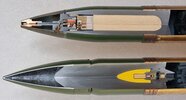 03 - M42A1 HE and M62A1 APC cartridges projectile detail.jpg989.3 KB · Views: 56
03 - M42A1 HE and M62A1 APC cartridges projectile detail.jpg989.3 KB · Views: 56 -
 04 - M61A1 en M62A1 cartridges.jpg480.8 KB · Views: 56
04 - M61A1 en M62A1 cartridges.jpg480.8 KB · Views: 56 -
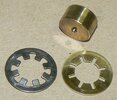 05 - Firing pin cilinder with resistance rings.JPG102.6 KB · Views: 47
05 - Firing pin cilinder with resistance rings.JPG102.6 KB · Views: 47 -
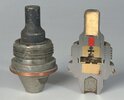 06 - Fuze BD M66.jpg58.7 KB · Views: 44
06 - Fuze BD M66.jpg58.7 KB · Views: 44 -
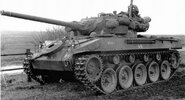 07 - M18 Hellcat.jpg51.2 KB · Views: 43
07 - M18 Hellcat.jpg51.2 KB · Views: 43 -
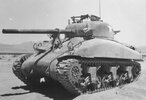 08 - 76mm Sherman M4A1.jpeg86.2 KB · Views: 52
08 - 76mm Sherman M4A1.jpeg86.2 KB · Views: 52
Last edited:

